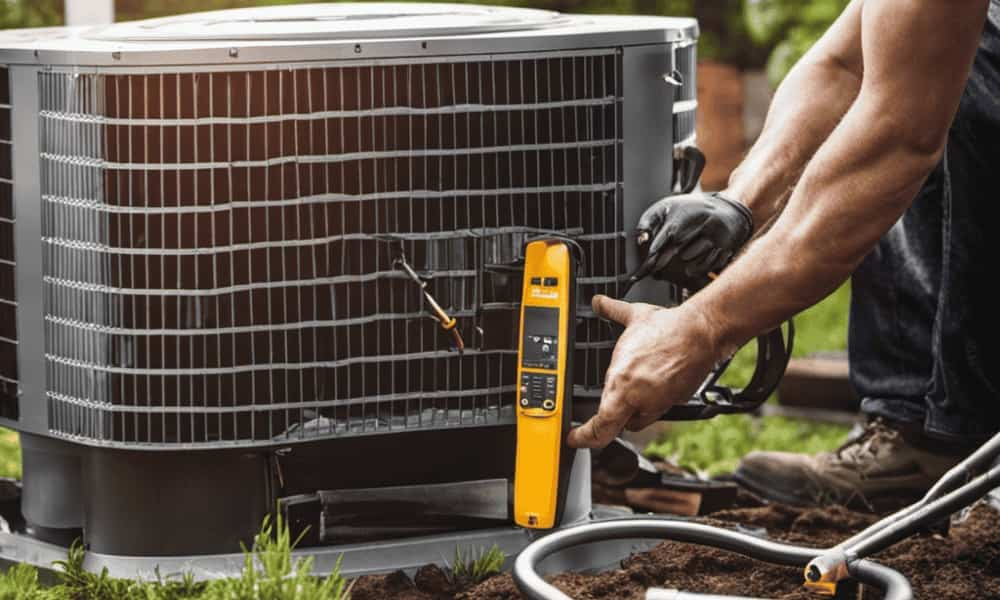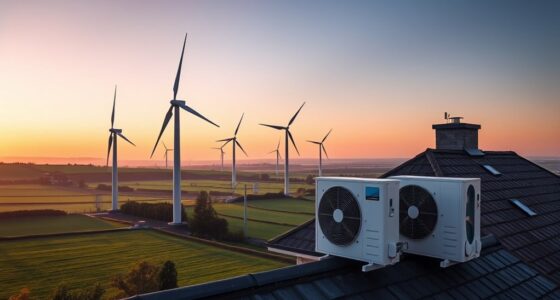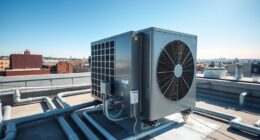Are you tired of traditional heating and cooling systems that waste energy and harm the environment? We have the perfect solution for you!
In this article, we’ll show you how to harness geothermal heat pumps for sustainable and efficient heating and cooling.
With our step-by-step guide, you’ll learn about the environmental benefits, choosing the right system, installation process, maximizing energy efficiency, and maintenance tips.
Get ready to revolutionize your energy consumption and join the innovative movement towards a greener future!

Key Takeaways
- Geothermal heat pumps utilize the constant temperature of the earth for heating and cooling, resulting in lower energy consumption and reduced carbon emissions.
- They offer higher energy efficiency ratios (EER) and coefficient of performance (COP) values, providing up to four units of heat for every unit of electricity used.
- Geothermal heat pumps use renewable energy sources, reducing greenhouse gas emissions and contributing to environmental sustainability.
- While initial installation costs may be higher, long-term savings on energy bills and maintenance make geothermal heat pumps cost-effective and help reduce dependence on non-renewable energy sources.
The Basics of Geothermal Heat Pumps
Let’s start by understanding the basics of geothermal heat pumps.
Geothermal heat pump technology is a sustainable and innovative solution for heating and cooling buildings. It harnesses the constant temperature of the earth to transfer heat, providing efficient and cost-effective climate control.
Geothermal heat pump installation involves drilling boreholes into the ground and installing a system of pipes filled with a heat transfer fluid. This fluid absorbs heat from the earth and carries it to a heat exchanger in the heat pump. The heat exchanger then transfers the heat to the building’s heating system.
Conversely, during cooling mode, the heat pump extracts heat from the building and transfers it back into the ground.

This technology offers significant energy savings, reduces greenhouse gas emissions, and provides a reliable and sustainable solution for heating and cooling needs.
Understanding the Environmental Benefits
Geothermal heat pumps offer several environmental benefits that make them a sustainable solution for heating and cooling.
One key advantage is their energy efficiency, as they can provide up to four units of heat for every unit of electricity used. This translates to lower energy consumption and reduced carbon emissions, making geothermal heat pumps a viable option for reducing our environmental impact.
Energy Efficiency Advantages
What are the energy efficiency advantages of geothermal heat pumps and how do they contribute to environmental sustainability? Geothermal heat pumps offer significant energy savings and cost benefits compared to traditional heating and cooling systems. By harnessing the constant temperature of the earth, these heat pumps can achieve higher energy efficiency ratios (EER) and coefficient of performance (COP) values. This means that for every unit of electricity used to power the heat pump, it can produce multiple units of heating or cooling energy. In fact, geothermal heat pumps can provide up to four times the amount of energy they consume, resulting in substantial energy savings. Additionally, these heat pumps reduce greenhouse gas emissions by using renewable energy sources, thereby contributing to environmental sustainability.

| Energy Efficiency Advantages of Geothermal Heat Pumps | Benefits |
|---|---|
| Higher Energy Efficiency Ratios (EER) and Coefficient of Performance (COP) | – Energy savings |
- Cost benefits |
| Up to four times the amount of energy produced compared to energy consumed | – Reduced electricity consumption - Lower utility bills |
| Use of renewable energy sources, reducing greenhouse gas emissions | – Environmental sustainability - Reduced carbon footprint |
Reduced Carbon Emissions
We can achieve a significant reduction in carbon emissions by utilizing geothermal heat pumps as a sustainable heating and cooling solution. Geothermal heat pump technology taps into the Earth’s natural heat, making it a renewable energy source that produces minimal greenhouse gas emissions.
Here are three reasons why geothermal heat pumps can help us reduce carbon emissions:
-
Energy efficiency: Geothermal heat pumps are highly efficient, using a small amount of electricity to transfer heat from the ground to the building. Compared to traditional heating and cooling systems, geothermal heat pumps can reduce carbon emissions by up to 70%.
-
Elimination of fossil fuels: Geothermal heat pumps don’t rely on fossil fuels like natural gas or oil for heating. By eliminating the combustion of these fuels, we can significantly reduce carbon emissions and dependence on non-renewable energy sources.

-
Renewable energy source: Geothermal energy is a sustainable and renewable resource. By harnessing the constant heat from the Earth’s core, we can produce clean energy without depleting finite resources or contributing to climate change.
Choosing the Right Geothermal Heat Pump System
When considering the most suitable geothermal heat pump system for our needs, it’s crucial to evaluate various factors such as energy efficiency, installation costs, and available space.
Geothermal heat pump sizing plays a significant role in determining the system’s capacity to meet our heating and cooling demands effectively. Proper sizing ensures optimal performance and energy savings. It’s essential to consider the size of our home or building, the climate conditions, and the desired indoor temperature.
Additionally, geothermal heat pump cost is another critical factor to consider. While the initial installation cost may be higher compared to conventional systems, the long-term savings on energy bills and maintenance expenses make it a cost-effective choice in the long run.

Site Evaluation and Installation Process
When evaluating geothermal site suitability, it’s essential to consider factors such as soil conditions, available space, and geological characteristics to ensure optimal heat transfer.
Efficient installation techniques play a crucial role in harnessing the full potential of geothermal heat pumps. By utilizing proper drilling and piping methods, as well as implementing effective heat exchange systems, we can maximize the energy efficiency and sustainability of geothermal heating and cooling systems.
Evaluating Geothermal Site Suitability
Assessing the geothermal site’s suitability involves conducting a thorough evaluation and installation process. To determine if a site is suitable for geothermal heat pumps, we consider several key factors:
-
Geological Factors:
We analyze the geological composition of the site, including the type of soil, rock formations, and groundwater conditions. Certain geological features, like the presence of hot springs or shallow bedrock, can indicate a higher heat transfer potential.
-
Heat Transfer Potential:
We assess the heat transfer potential of the site by conducting thermal conductivity tests. These tests measure how well heat can be transferred from the ground to the geothermal system. Higher thermal conductivity values indicate better heat transfer potential. -
Environmental Considerations:
We also evaluate the environmental impact of the installation process. This involves assessing factors such as noise levels, land disturbance, and potential disruption to local ecosystems.
Efficient Installation Techniques
To ensure efficient installation of geothermal heat pumps, we carefully evaluate the site and follow a precise installation process. By implementing efficient installation techniques, we can maximize the performance of geothermal heat pump systems while minimizing costs.
One cost-effective strategy is to conduct a thorough site evaluation before installation. This involves assessing the geology and hydrology of the site to determine the feasibility of a geothermal system. By understanding the subsurface conditions, we can optimize the design and sizing of the system, resulting in higher energy efficiency.

Additionally, the installation process itself must be carefully executed to ensure proper system performance. This includes proper sizing and placement of the heat pump, as well as proper sealing and insulation of the piping system.
Maximizing Energy Efficiency With Geothermal Heat Pumps
We can increase energy efficiency by implementing three key strategies when utilizing geothermal heat pumps:
-
Optimize geothermal heat pump technology: By selecting the right geothermal heat pump system, we can ensure maximum efficiency. Factors to consider include the size of the heat pump, the type of refrigerant used, and the overall design of the system. Investing in advanced technologies such as variable speed compressors and smart controls can further enhance energy efficiency.
-
Design for optimal performance: Proper design is crucial for maximizing energy efficiency. This includes sizing the system correctly to meet the heating and cooling demands of the building, as well as designing an efficient ground loop system. Utilizing ground source heat exchangers and incorporating thermal storage can also improve system performance.

-
Implement effective controls and monitoring: Monitoring and controlling the geothermal heat pump system is essential for maintaining high energy efficiency. Smart controls can optimize system performance by adjusting settings based on occupancy schedules, outdoor temperature, and other factors. Regular monitoring and maintenance can identify and address any issues that may arise, ensuring the system operates at peak efficiency.
By following these strategies, we can harness the full potential of geothermal heat pump technology and design to maximize energy efficiency in our buildings.
Transitioning to the next section, let’s now explore some maintenance and troubleshooting tips to ensure the longevity and effectiveness of our geothermal heat pump systems.
Maintenance and Troubleshooting Tips
What are some key maintenance and troubleshooting tips to ensure the longevity and effectiveness of our geothermal heat pump systems?

Regular maintenance is crucial for the efficient operation of geothermal heat pumps. First, it’s important to clean or replace air filters every three months to prevent clogging and maintain optimal airflow.
Additionally, inspect the outdoor unit for debris and clear any obstructions to ensure proper heat exchange. Regularly check the refrigerant levels and ensure there are no leaks, as low refrigerant can reduce the system’s efficiency.
Furthermore, inspect and clean the indoor coils and blower to prevent the buildup of dirt and dust.
For troubleshooting, if the system isn’t heating or cooling effectively, check the thermostat settings, power supply, and circuit breakers. If issues persist, consult a professional technician for further assistance.

Case Studies: Successful Applications of Geothermal Heat Pumps
Two case studies demonstrate the successful applications of geothermal heat pumps in achieving sustainable energy solutions.
- Case Study 1: Commercial Building Retrofit
- A large commercial building in a major city implemented a geothermal heat pump system as part of its energy efficiency retrofit.
- The system utilized the constant temperature of the ground to provide heating and cooling, resulting in significant energy savings.
- The building’s carbon footprint was reduced by 30%, and the geothermal heat pump system paid for itself within five years.
- Case Study 2: Residential Development
- A new residential development in a suburban area incorporated geothermal heat pumps in each home.
- The system utilized the stable temperature of the ground to heat and cool the homes efficiently.
- Homeowners experienced a 50% reduction in their energy bills, and the development received recognition for its sustainable design and contribution to the local environment.
These case studies illustrate the successful implementation of geothermal heat pumps in both commercial and residential settings, highlighting their significant contribution to sustainability and energy efficiency.
Frequently Asked Questions
How Long Does It Typically Take for a Geothermal Heat Pump System to Pay for Itself in Energy Savings?
It typically takes several years for a geothermal heat pump system to pay for itself in energy savings. This is due to the initial geothermal heat pump cost and the high geothermal heat pump efficiency, which allows for significant long-term energy savings.
Are Geothermal Heat Pump Systems Suitable for All Types of Homes, or Are There Certain Factors That May Make a Home Unsuitable for Installation?
Geothermal heat pump systems offer sustainable solutions for homes. Factors like land availability, soil conditions, and upfront costs may affect installation suitability. However, with proper assessment and innovative design, many homes can benefit from harnessing geothermal heat.

Can Geothermal Heat Pumps Be Used for Both Heating and Cooling, or Are They Primarily Used for One or the Other?
Geothermal heat pumps can be used for both heating and cooling, making them versatile for various applications. They can be harnessed for commercial buildings and agricultural purposes, offering sustainable solutions that promote energy efficiency and environmental stewardship.
What Are the Potential Drawbacks or Limitations of Installing a Geothermal Heat Pump System?
Potential drawbacks and limitations of geothermal heat pump installation include high upfront costs, site suitability, and the need for skilled professionals. However, government incentives and long-term energy savings, along with the heating and cooling capabilities, can provide a favorable payback period.
Are There Any Government Incentives or Tax Credits Available for Those Who Choose to Install a Geothermal Heat Pump System?
Government incentives and tax credits can be beneficial for those who choose to install a geothermal heat pump system. These financial incentives encourage the adoption of sustainable technologies and help offset the initial installation costs, making geothermal heat pumps a more attractive and accessible option.
Conclusion
In conclusion, geothermal heat pumps offer a sustainable solution for heating and cooling systems. By harnessing the Earth’s natural heat, we can reduce our reliance on fossil fuels and minimize our carbon footprint.

With proper installation and maintenance, these systems can provide long-term energy efficiency and cost savings. Like a hidden treasure waiting to be discovered, geothermal heat pumps hold the key to a more sustainable and eco-friendly future.
Let’s unlock their potential and embrace this renewable energy source.









